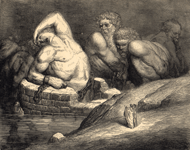
More Giants (Briareus, Tityus, Typhon): Circle 9, Inferno 31 Although Dante and Virgil do not visit them, three more towering Giants are named in Inferno 31. Briareus, whom Virgil describes as equal in size to--but even more terrifying than--Ephialtes (Inf. 31.103-5), appears in Virgil's epic as a monster said to have one hundred arms and hands, with fire burning in his fifty mouths and chests; he thus wielded fifty shields and swords to defend himself against Jove's thunderbolts (Aen. 6.287; 10.565-8). Statius merely describes Briareus as immense (Thebaid 2.596). Repeating Lucan's coupling of Tityus and Typhon as Giants inferior to Antaeus (Pharsalia 4.595-6), Virgil appeals to Antaeus' pride by "threatening" to go to them if Antaeus will not provide a lift down to circle 9 (Inf. 31.124-6). Tityus is well represented in classical literature as a Giant whose attempted rape of Latona (mother of Apollo and Diana) earns him a gruesome fate in the underworld: a vulture continuously feeds on Tityus' immortal liver (Aen. 6.595-600; Met. 4.457-8). Typhon was struck down by Jove's lightning bolts and, depending on the version, buried under either Mount Etna in Sicily (and thus the catalyst for occasional volcanic eruptions) or the Island of Ischia in the Bay of Naples (Aen. 9.715-6; Met. 5.318-58). |